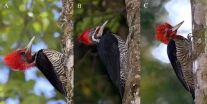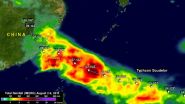Deceptive woodpecker uses mimicry to avoid competition
2015-08-11
(Press-News.org) Birds of a feather may flock together, but that doesn't mean they share a genetic background. Though birds were first classified into groups primarily based on appearance, research forthcoming in The Auk: Ornithological Advances by Brett Benz of the American Museum of Natural History, Mark Robbins of the University of Kansas Biodiversity Institute, and Kevin Zimmer of the Los Angeles County Museum of Natural History demonstrates that this method isn't necessarily accurate: in a group of very similar-looking South American woodpecker species, genetic analysis has now shown one to be only a distant cousin of the others, in an intriguing case of visual mimicry. By copying the appearance of larger, socially dominant woodpecker species, it reduces the aggression and competitive interference that it receives from them and has more access to food resources as a result.
The most familiar type of mimicry typically involves warning or "aposematic" coloration, in which a harmless species apes the color patterns of a dangerous or unappealing one to avoid predators; a famous instance is the Viceroy butterfly, which shares the striking colors of the more noxious Monarch. By contrast, the Helmeted Woodpecker (Dryocopus galeatus) represents an example of a different and less well understood form of mimicry, known as interspecific social dominance mimicry or ISDM.
The shy and little-known species shares the red crest, black back, and barred underside of two larger woodpeckers Dryocopus lineatus and Campephilus robustus, all of which occupy the same habitat and share similar food preferences. The Helmeted Woodpecker's similarity in appearance makes the larger, more dominant woodpecker species less likely to attack it, due to the costs of aggression between members of the same species. Though they had been previously classified in Dryocopus due to the remarkable similarities in their appearance, genetic analysis by Benz and his colleagues suggests that the Helmeted Woodpecker is actually not closely related to other Dryocopus woodpeckers at all and belongs in a different genus, Celeus. An independent group of researchers using the same data recently reported similar results in a paper published in the Journal of Ornithology.
"Co-author Mark Robbins and I had just finished a phylogenetic study examining species limits and vocalizations in Celeus woodpeckers when Mark, who was attending a meeting in Brazil, had the opportunity to observe a Helmeted Woodpecker at Intervales State Park," according to Benz. "Upon hearing the bird vocalize, Mark was stunned that its call sounded nothing like Neotropical Dryocopus, and immediately knew we needed to examine its taxonomic status in the context of our recent Celeus study given that the Helmeted Woodpecker calls were most similar to several other Celeus species. Upon returning from Brazil, Mark consulted with co-author Kevin Zimmer, who had independently arrived at the same conclusions about the Helmeted Woodpecker belonging with Celeus, based on his behavioral observations spanning 20 years of fieldwork in Brazil." As Benz puts it, "The Helmeted Woodpecker is basically a typical Celeus in Dryocopus clothing."
"After several decades working on the discovery of the avian Tree of Life, it is still amazing what we are discovering! Reconstructing the phylogeny of these woodpeckers has corrected a century-old classification mistake, but more interestingly, it has revealed an unexpected new example of avian mimicry," adds Richard Prum of Yale University, one of the originators of the ISDM hypothesis. "It has only recently been appreciated that small species may benefit from deceptively mimicking larger species to protect themselves from aggressive attack. This is similar to how a 12-year-old kid walking home from school will look and act tough to try to prevent himself from being harassed by older, bigger kids."
Relatively little is known about the ecology and natural history of the Helmeted Woodpecker, which is found in Brazil, Paraguay, and Argentina, but it has experienced dramatic population declines and vanished from much of its former range due to deforestation. Hopefully, this new discovery about its evolutionary relationships and visual deception may increase interest in the species, as it provides an opportunity for scientists to further test predictions associated with ISDM. Ultimately, bringing the Helmeted Woodpecker's sneaky strategy into the light may be what saves it from oblivion.
INFORMATION:
"Phylogenetic relationships of the Helmeted Woodpecker (Dryocopus galeatus): A case of interspecific mimicry?" will be published on September 30, 2015, and will be available at http://www.aoucospubs.org/toc/tauk/132/4; a pre-print version is available at http://dx.doi.org/10.1101/023663.
About the journal: The Auk: Ornithological Advances is a peer-reviewed, international journal of ornithology that began in 1884 as the official publication of the American Ornithologists' Union. In 2009, The Auk was honored as one of the 100 most influential journals of biology and medicine over the past 100 years.
[Attachments] See images for this press release:

ELSE PRESS RELEASES FROM THIS DATE:
2015-08-11
The immune system not only responds to infections and other potentially problematic abnormalities in the body, it also contains a built-in brake in the form of regulatory T cells, or Tregs. Tregs ensure that inflammatory responses don't get out of hand and do damage. In autoimmune diseases, sometimes these Treg cells don't act as they should.
A new study led by Songtao Shi of the University of Pennsylvania has demonstrated how Tregs can themselves be regulated, by an unexpected source: hydrogen sulfide, a gas produced by the body's muscle cells and one often associated ...
2015-08-11
MADISON, Wis. -- Graphene, an atom-thick material with extraordinary properties, is a promising candidate for the next generation of dramatically faster, more energy-efficient electronics. However, scientists have struggled to fabricate the material into ultra-narrow strips, called nanoribbons, that could enable the use of graphene in high-performance semiconductor electronics.
Now, University of Wisconsin-Madison engineers have discovered a way to grow graphene nanoribbons with desirable semiconducting properties directly on a conventional germanium semiconductor wafer. ...
2015-08-11
(SACRAMENTO, Calif.) -- In findings never before seen in melanoma, a novel combination therapy was found to be highly effective at treating patients with skin metastases, new research from UC Davis has shown.
Led by Emanual Maverakis of the UC Davis Department of Dermatology, the research found that Interleukin (IL)-2 combined with imiquimod and topical retinoid therapy in patients with so-called "in-transit metastases" is a promising therapeutic option.
The findings have been published online first in the Journal of the American Academy of Dermatology (doi:10.1016/j.jaad.2015.06.060).
"It's ...
2015-08-11
People infected with the hepatitis C virus are at risk for liver damage, but the results of a new Johns Hopkins study now show the infection may also spell heart trouble.
The findings, described online July 27 in The Journal of Infectious Diseases, emerged from a larger ongoing study of men who have sex with men, many but not all of whom were infected with HIV and followed over time to track risk of infection and disease progression. A subset of the participants had both HIV and hepatitis C, two infections that often occur together.
Even though people infected with ...
2015-08-11
New research from Monash University shows that children are being exposed to thousands of alcohol adverts when watching sport TV, questioning the effectiveness of advertising regulations designed to protect children.
The study, published in the international journal PLOS ONE, found that 87 per cent of all alcohol adverts during the daytime were in sport TV when hundreds of thousands of children were watching. A clause in Australia's advertising regulations allowing alcohol advertising in live sport programming during the day when children are watching appears to be responsible ...
2015-08-11
From its orbit around the Earth, the NASA-NOAA Suomi National Polar-orbiting Partnership satellite or Suomi NPP satellite, captured a night-time image of California's Jerusalem Fire.
InciWeb is an interagency all-risk incident information management system that coordinates with federal, state and local agencies to manage wildfires. According to Inciweb, this fire is burning on lands managed by the U.S. Bureau of Land Management within the Berryessa Snow Mountain National Monument. It is being managed by the Sonoma-Lake-Napa Unit of the California Department of Forestry ...
2015-08-11
MADISON, Wis. -- Human learning is a complex, sometimes mysterious process. Most of us have had experiences where we have struggled to learn something new, but also times when we've picked something up nearly effortlessly.
What if a fusion of computer science and psychology could help us understand more about how people learn, making it possible to design ideal lessons?
That long-range goal is moving toward reality thanks to an effort led by professors in the University of Wisconsin-Madison departments of computer sciences, psychology and educational psychology. Their ...
2015-08-11
Typhoon Soudelor dropped over two feet of rainfall when it made landfall in China in early August, and soaked Taiwan. NASA estimated that rainfall using data from the Global Precipitation Measurement (GPM) mission.
Soudelor formed in the middle of the Pacific Ocean well east of Guam on July 20, 2015. Soudelor became more powerful with peak intensity of about 155 knots (178 mph) reached on August 3, 2015 when the super typhoon was well east of Taiwan over the open waters of the Pacific Ocean.
Soudelor's winds died down a little but rebounded to with over 100 knots (115 ...
2015-08-11
Swine housing has been a hot topic in recent years, not only in the United States, but in many countries, such as Denmark. Due to genetic advancements in recent years, the average litter size in Denmark is 16.6 total born piglets. With increased number of piglets, determining the optimal housing system for both the piglet and sow is critical.
In Denmark, gestation crates were banned in new buildings in 1999 and from all existing units in 2013. As of January 1, 2015, sows are required to be loose housed from time of weaning until seven days before expected parturition ...
2015-08-11
August 6, 2015 - According to the Association for Pet Obesity Prevention in 2014, approximately 53% and 58% of dogs and cats, respectively, in the United States were overweight and obese. These numbers have steadily increased since 2010. However, most pet owners (? 90%) do not realize and cannot identify that their pets are overweight/obese.
What can we do about this growing problem? Pet food companies and nutritionists are searching for ingredients, like prebiotics and probiotics, to combat these conditions. But, could the problem have another solution?
Dr. Aulus Carciofi, ...
LAST 30 PRESS RELEASES:
[Press-News.org] Deceptive woodpecker uses mimicry to avoid competition


